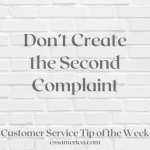I don’t promote scripting, because too many companies take it literally in that they force their employees – without the least bit of sincerity – to make the same statements over and over and over again to the customer.
“Did I deliver great service today?"
“I hope I provided excellent customer service.”
Customers can sense sincerity and insincerity, communications they trust and mistrust.
So when we hear that some companies have their customer service reps and other staff use those statements because “Great” and “Excellent” are ratings on the surveys, I cringe.
Don’t rig the surveys just to have them say what you want them to say in terms of “Excellent” or “Great.” Customers can usually smell that a mile away, and just as importantly, you may not be getting a true indication of your customer’s satisfaction.
Now when it IS beneficial to have a little bit of scripting and training and education with staff that relates to surveys is when the terminology you use to describe the attribute they’re evaluating is not obvious. Maybe you ask on the surveys about “discharge instructions,” but when you talk to the patient in the hospital, you never referenced the phrase “discharge instructions.” In these cases, either refer to “discharge instructions” using that term when they’re in the hospital so the patient knows what you’re talking about on the survey, or use a more simple term or phrase on the survey like “Did they explain how to care for yourself when you go home?”.
When you’re conducting a survey and you’re asking the season ticket holder for the pro sports team to evaluate their account representative, make sure they know about whom you’re talking. Have the representatives refer to themselves as “your account representative” or “your personal representative with the team” when talking to the season ticket holder.
Make sure that the terms you use on surveys are terms customers are familiar with from having dealt with your organization. If you want great performance, you have to make it clear with your employees what great performance looks like, and to evaluate that performance, use terms on the surveys that you commonly use with your customers.
Read our New Book – “Ask Yourself…Am I GREAT at Customer Service?” http://www.amigreatat.com/
Interested in improving your company’s customer service? See more at our new website! http://www.cssamerica.com/





















